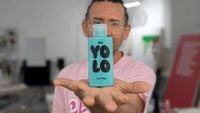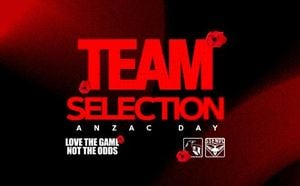In a vibrant intersection of art and science, the world is buzzing over a newly described color dubbed "Olo," which has inspired British artist Stuart Semple to create a unique paint named YOLO. This innovative paint aims to capture the essence of Olo, a color experience evoked by researchers at the University of California, Berkeley. The scientists used specialized lasers to stimulate individual cells in the retinas of five volunteers, expanding their perception of color beyond the typical human experience. The result? A visually stunning, intensely saturated greenish-blue hue reminiscent of a fluorescently glowing teal.
On April 24, 2025, this fascinating blend of art and science was highlighted in various media outlets, showcasing Semple’s latest endeavor. Known for his colorful provocations, Semple has a history of creating pigments that challenge conventional boundaries. He previously made headlines with the creation of the world’s blackest black paint and the pinkest pink, both of which have sparked significant conversations in the art community.
Semple's paint, YOLO, is not just another color; it is a statement. To recreate the extraordinary visual experience of Olo, he mixed pigments with a strong dose of fluorescent optical brighteners—chemical compounds that absorb ultraviolet light and re-emit it as visible blue light. These brighteners are commonly found in laundry detergents and purple shampoos, making materials appear more vibrant. While Semple acknowledges that his paint cannot exactly replicate the Olo experience, he argues that it is the closest one can get to experiencing it in reality. He insists that the true beauty of YOLO is best appreciated in person, as its unique visual effects depend on light interaction.
In an intriguing twist, Semple's YOLO is set at a price point of £10,000 (around $13,300) for non-artists. However, artists can purchase it for just £29.99 ($39.92), provided they commit to using it solely for artistic applications. This pricing strategy reflects Semple's commitment to ensuring that his creations remain in the hands of artists rather than scientists, a sentiment that echoes his past confrontations with the art world.
One of the most notable conflicts in Semple’s career was his rivalry with British-Indian artist Anish Kapoor, who gained exclusive rights to use Vantablack, a pigment that absorbs 99.965 percent of visible light, creating an almost complete visual void. In response to Kapoor's controversial acquisition, Semple created a pigment that he claimed was even darker and made it available to the public—except for Kapoor, who was explicitly banned from using it. This playful yet pointed approach to artistic rivalry has positioned Semple as a provocateur in the art community.
Meanwhile, the Italian design world is also making waves as the colorful legacy of Italy's iconic train, designed by renowned architects Gio Ponti and Giulio Minoletti in the 1950s, was recently unveiled at the Italian pavilion in Expo 2025 Osaka. This innovative design showcases a commitment to sustainability, utilizing fuel derived from cooking oils and animal fats. The pavilion serves as a platform for highlighting Italy's rich design heritage while also embracing contemporary ecological practices.
The Expo 2025 event is set to be a significant gathering for the design community, with Milan Design Week 2025 on the horizon. This week-long celebration in Milan is a pivotal moment when designers from around the globe converge to showcase their latest creations and innovations. It’s a time when the city transforms into a hub of creativity and inspiration, attracting both industry professionals and design enthusiasts.
As the design and art worlds continue to evolve, the interplay between new scientific discoveries and artistic expression becomes increasingly significant. Semple’s YOLO paint stands as a testament to this relationship, bridging the gap between the scientific exploration of color and its artistic applications. His work not only invites viewers to reconsider their perceptions of color but also challenges the boundaries of what art can be.
In the words of Semple, "There’s a bit of debate about whether it can be considered a 'new color,' but it’s evident the technique creates a visual experience that’s unfamiliar to anything we see in everyday reality." This sentiment resonates deeply within the art community, as artists and scientists alike grapple with the implications of such discoveries.
As we look forward to Milan Design Week and the ongoing dialogue surrounding color and perception, one thing is clear: the fusion of art and science will continue to inspire and provoke thought in ways we have yet to fully understand. Whether through Semple's playful provocations or the innovative designs showcased at Expo 2025, the future of color and design is undoubtedly bright.




